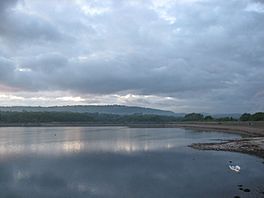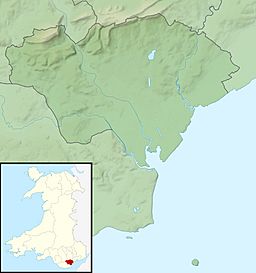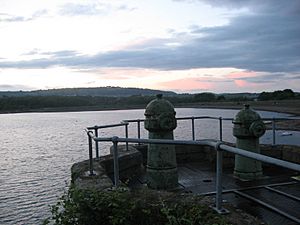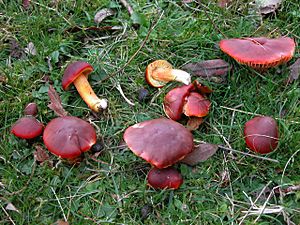Llanishen Reservoir facts for kids
Quick facts for kids Llanishen Reservoir |
|
|---|---|

Llanishen reservoir (semi-drained)
|
|
| Location | Llanishen, Cardiff, Wales |
| Coordinates | 51°31′43″N 3°10′21″W / 51.52861°N 3.17250°W |
| Type | Reservoir |
| Primary inflows | Rainfall |
| Primary outflows | Drainage |
| Basin countries | United Kingdom |
| Built | 1886 |
| First flooded | 1886 |
| Surface area | 23.8 ha (59 acres) |
| Max. depth | 9 m (30 ft) |
| Water volume | 1,440,909 m3 (50,885,200 cu ft) |
| Surface elevation | 45 m (148 ft) |
| Frozen | Last frozen during Winter 09/10 |
Llanishen Reservoir (Welsh: Cronfa Ddŵr Llanisien) is a large lake built by people in North Cardiff, Wales. It was finished in 1886 during the Victorian era. This reservoir was part of a big plan to bring water to Cardiff from the Taff Fawr area. It is also part of the beautiful Nant Fawr Corridor, which stretches from Roath Park into the countryside.
The reservoir supplied water until the mid-1970s. After that, it was used for fun activities like sailing. It also helped to top up the nearby Lisvane Reservoir. Later, it was completely drained. The company that owned it, Western Power Distribution (WPD), wanted to build on the land. But many groups, including the local council and residents, stopped this plan. On August 30, 2013, WPD sold both Llanishen and Lisvane reservoirs to CELSA Group.
In January 2016, Welsh Water took over both reservoirs from CELSA Group with a very long lease (999 years!). This means Welsh Water can use them for water supply and for fun activities again. CELSA UK can still get its water from Lisvane reservoir.
Contents
History of Llanishen Reservoir
In 1881, the Cardiff Corporation (like the city council today) asked an engineer named John Avery Brandon Williams to find good water sources for Cardiff. He suggested building reservoirs on the upper Taff Fawr. He also said that Llanishen Reservoir, which was already approved by a special law in 1878, should be built quickly.
The Corporation decided to build Llanishen Reservoir first. This was so they wouldn't lose extra water from the Lisvane area while the bigger Taff Fawr project was being built. The first work started in 1882. After some changes in contractors, T A Walker finished building the reservoir in 1886. Walker used a special railway with three steam engines to help with the construction!
The reservoir was built on flat land. It has a high earth wall all around it with a clay center. It doesn't connect to local streams like the Nant Fawr. At first, it filled up with rainwater. But later, pipes were built to connect it to the Taff Fawr reservoirs. This allowed Llanishen to supply Cardiff with a lot of clean water every day. The wall is about 10 metres (33 ft) high and 1,173 metres (3,848 ft) long. The reservoir can hold about 1,440,909 cubic metres (50,885,200 cu ft) of water.
The reservoir land has special types of rocks and soil underneath it. In 1973, the reservoir became part of Welsh Water. It supplied water until the mid-1970s. Later, the company that owned Welsh Water was sold to WPD in 2001. WPD then sold the reservoir to a different part of their company.
Since the 1970s, the reservoir has mostly been used for fun activities and to fill up the nearby Lisvane Reservoir.
Protecting Nature at the Reservoir
Llanishen Reservoir is a special place for nature. It is listed as a Site of Nature Conservation Interest (SNCI). This means it's important for plants like pondweed and stonewort. It's also a breeding spot for common toads. The grassy areas around the reservoir are also an SNCI because of the grass snakes and slowworms that live there.
The banks of the reservoir are even more special! They are a Site of Special Scientific Interest (SSSI). This is because many different kinds of colorful waxcap fungi grow there. The company that owned the reservoir tried to stop this listing, but a judge said in 2007 that it was "an important site."
In 2009, the reservoir was also listed as a historic building by Cadw. This means it's important for its history or special design.
Fun Activities at the Reservoir
Until 2010, the Cardiff Sailing Centre was based at Llanishen Reservoir. They taught people how to do dinghy sailing, windsurfing, powerboating, and canoeing. The center had been there for 30 years. It had to move to Cardiff Bay when the reservoir was drained.
The sailing center was very good at teaching beginners and training top racers. Many national and international sailors learned there.
The reservoir was also a popular spot for other activities. People enjoyed fishing (with the Cardiff Fly Fishing Club), having picnics, watching birds, and going for walks. Fishing stopped in 1998. Many other activities were limited after 2004 because a security fence was built around the reservoir.
Even with the fences, some people still walk between them. This is because there are natural gaps in the outer fence and hedges.
Images for kids







